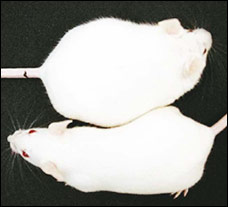Chemicals May Play Role in Rise in ObesityBy Elizabeth GrossmanWashington Post Mar. 12, 2007 |
Popular 
America Last: House Bill Provides $26B for Israel, $61B for Ukraine and Zero to Secure U.S. Border

Bari Weiss' Free Speech Martyr Uri Berliner Wants FBI and Police to Spy on Pro-Palestine Activists

Report: Blinken Sitting On Staff Recommendations to Sanction Israeli Military Units Linked to Killings or Rapes

Telegram Founder Changed Mind on Setting Up Shop in San Francisco After Being Robbed Leaving Twitter HQ

MSNBC's Joy Reid Celebrates Prosecution of Trump as Racial Revenge Against Whitey
  Too many calories and too little exercise are undeniably the major factors contributing to the obesity epidemic, but several recent animal studies suggest that environmental exposure to widely used chemicals may also help make people fat. Too many calories and too little exercise are undeniably the major factors contributing to the obesity epidemic, but several recent animal studies suggest that environmental exposure to widely used chemicals may also help make people fat.The evidence is preliminary, but a number of researchers are pursuing indications that the chemicals, which have been shown to cause abnormal changes in animals' sexual development, can also trigger fat-cell activity -- a process scientists call adipogenesis. The chemicals under scrutiny are used in products from marine paints and pesticides to food and beverage containers. A study by the Centers for Disease Control and Prevention found one chemical, bisphenol A, in 95 percent of the people tested, at levels at or above those that affected development in animals. These findings were presented at last month's annual meeting of the American Association for the Advancement of Science. A spokesman for the chemical industry later dismissed the concerns, but Jerry Heindel, a top official of the National Institute of Environmental Health Sciences (NIEHS), who chaired the AAAS session, said the suspected link between obesity and exposure to "endocrine disrupters," as the chemicals are called because of their hormone-like effects, is "plausible and possible." Bruce Blumberg, a developmental and cell biologist at the University of California at Irvine, one of those presenting research at the meeting, called them "obesogens" -- chemicals that promote obesity. Obesity has become a major health concern as people in the United States and around the world have become increasingly overweight, raising their risk of cardiovascular diseases, diabetes, stroke and certain cancers. The World Health Organization estimates that more than a billion adults worldwide are overweight and 300 million are obese. Scientists have begun examining a wide range of possible causes beyond eating too much and exercising too little -- including possible chemical exposures. Blumberg began to suspect a link while trying to pinpoint how one endocrine disrupter, tributyltin, affects genetic mechanisms in the reproductive system. Tributyltin is used as a marine and agricultural fungicide, an antimicrobial agent in industrial water systems, and in plastics; it can cause serious sexual abnormalities in marine animals. "What we discovered," Blumberg said, is that tributyltin disrupted genetic interactions that regulate fat-cell activity in animals. "Exposure to tributyltin is increasing the number of fat cells, so the individual will get fatter faster as these cells produce more of the hormones that say 'feed me,'" Blumberg said. The exposed animals, he added, remain predisposed to obesity for life. Retha R. Newbold, a developmental biologist at the NIEHS, has seen similar lifetime effects in her work with diethylstilbestrol (DES), a potent synthetic estrogen she has studied for 30 years. Newbold's research has shown that mice exposed to DES during early development produced more fat cells, larger fat cells, and more abdominal fat than those not exposed. Exposed mice became obese adults and remained obese even on reduced calorie and increased exercise regimes. Like tributyltin, DES appeared to permanently disrupt the hormonal mechanisms regulating body weight. "Once these genetic changes happen in utero, they are irreversible and with the individual for life," Newbold said. DES was widely prescribed for women during pregnancy from the 1940s until 1971, when it was withdrawn after being linked to cancer. Taken by perhaps 8 million women, DES has caused reproductive abnormalities in children and grandchildren of women who took it. Whether its effects include promoting obesity has yet to be determined, but its effects on animal metabolism -- it is also used to fatten livestock -- are similar to those caused by bisphenol A, a chemical most people now encounter daily. "Exposure to bisphenol A is continuous," said Frederick vom Saal, professor of biological sciences at the University of Missouri at Columbia. Bisphenol A is an ingredient in polycarbonate plastics used in many products, including refillable water containers and baby bottles, and in epoxy resins that line the inside of food cans and are used as dental sealants. In 2003, U.S. industry consumed about 2 billion pounds of bisphenol A. Researchers have studied bisphenol A's effects on estrogen function for more than a decade. Vom Saal's research indicates that developmental exposure to low doses of bisphenol A activates genetic mechanisms that promote fat-cell activity. "These in-utero effects are lifetime effects, and they occur at phenomenally small levels" of exposure, vom Saal said. Steven Hentges of the American Chemistry Council said his organization's review of the scientific literature found that a preponderance of the bisphenol A studies have shown no adverse effects, including no increased body weight. "Our conclusion is that there is no risk to human health," said Hentges. But many scientists disagree, including vom Saal, who called the ACC's statements a "blatant lie." Research into the impact of endocrine-disrupting chemicals on obesity has been done only in laboratory animals, but the genetic receptors that control fat cell activity are functionally identical across species. "They work virtually the same way in fish as they do in rodents and humans," Blumberg said. "Fat cells are an endocrine organ." Ongoing studies are monitoring human levels of bisphenol A, but none have been done of tributyltin, which has been used since the 1960s and is persistent in the marine food web. "Tributyltin is the only endocrine disrupting chemical that has been shown without substantial argument to have an effect at levels at which it's found in the environment," Blumberg said. Concern over tributyltin's reproductive effects on marine animals has resulted in an international agreement discontinuing its use in anti-fouling paints used on ships. The EPA has said it plans next year to assess its other applications, including as an antimicrobial agent in livestock operations, fish hatcheries and hospitals. Bisphenol A is approved by the Food and Drug Administration for use in consumer products, and the agency says the amount of bisphenol A or tributyltin that might leach from products is too low to be of concern. But the National Toxicology Program, part of the National Institutes of Health, is reviewing bisphenol A, and concerns about its estrogenic effects prompted California legislators to propose banning it from certain products sold in-state, a move industry has fought vigorously. Researchers said the next step is to learn if these apparent animal "obesogens" are affecting people. "Our job is to follow the science, and based on these animal studies, this is worth taking a look at," said Heindel of the NIEHS. Related: Who Controls the Food Controls the People |



